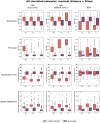Investigating the effect of template head models on Event-Related Potential source localization: a simulation and real-data study
- PMID: 39440187
- PMCID: PMC11493687
- DOI: 10.3389/fnins.2024.1443752
Investigating the effect of template head models on Event-Related Potential source localization: a simulation and real-data study
Abstract
Introduction: Event-Related Potentials (ERPs) are valuable for studying brain activity with millisecond-level temporal resolution. While the temporal resolution of this technique is excellent, the spatial resolution is limited. Source localization aims to identify the brain regions generating the EEG data, thus increasing the spatial resolution, but its accuracy depends heavily on the head model used. This study compares the performance of subject-specific and template-based head models in both simulated and real-world ERP localization tasks.
Methods: Simulated data mimicking realistic ERPs was created to evaluate the impact of head model choice systematically, after which subject-specific and template-based head models were used for the reconstruction of the data. The different modeling approaches were also applied to a face recognition dataset.
Results: The results indicate that the template models capture the simulated activity less accurately, producing more spurious sources and identifying less true sources correctly. Furthermore, the results show that while creating more accurate and detailed head models is beneficial for the localization accuracy when using subject-specific head models, this is less the case for template head models. The main N170 source of the face recognition dataset was correctly localized to the fusiform gyrus, a known face processing area, using the subject-specific models. Apart from the fusiform gyrus, the template models also reconstructed several other sources, illustrating the localization inaccuracies.
Discussion: While template models allow researchers to investigate the neural generators of ERP components when no subject-specific MRIs are available, it could lead to misinterpretations. Therefore, it is important to consider a priori knowledge and hypotheses when interpreting results obtained with template head models, acknowledging potential localization errors.
Keywords: EEG; EEG source localization; ERP; Event-Related Potentials; head modeling; source estimation.
Copyright © 2024 Depuydt, Criel, De Letter and van Mierlo.
Conflict of interest statement
The authors declare that the research was conducted in the absence of any commercial or financial relationships that could be construed as a potential conflict of interest.
Figures







Similar articles
-
Evaluating Head Models for Cortical Source Localization of the Face-Sensitive N290 Component in Infants.Brain Topogr. 2022 Jul;35(4):398-415. doi: 10.1007/s10548-022-00899-9. Epub 2022 May 11. Brain Topogr. 2022. PMID: 35543889
-
Bayesian model selection of template forward models for EEG source reconstruction.Neuroimage. 2014 Jun;93 Pt 1:11-22. doi: 10.1016/j.neuroimage.2014.02.022. Epub 2014 Feb 26. Neuroimage. 2014. PMID: 24582919
-
Neuroanatomic localization of priming effects for famous faces with latency-corrected event-related potentials.Brain Res. 2016 Feb 1;1632:58-72. doi: 10.1016/j.brainres.2015.12.001. Epub 2015 Dec 9. Brain Res. 2016. PMID: 26683085
-
Time course of ERP generators to syllables in infants: a source localization study using age-appropriate brain templates.Neuroimage. 2012 Feb 15;59(4):3275-87. doi: 10.1016/j.neuroimage.2011.11.048. Epub 2011 Dec 1. Neuroimage. 2012. PMID: 22155379
-
Mapping of the neuronal networks of human cortical brain functions.Adv Tech Stand Neurosurg. 2003;28:91-142. doi: 10.1007/978-3-7091-0641-9_2. Adv Tech Stand Neurosurg. 2003. PMID: 12627809 Review.
References
LinkOut - more resources
Full Text Sources

